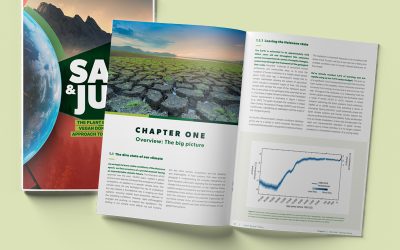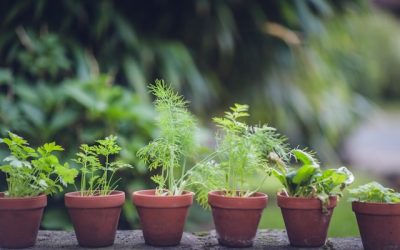Blog
Your Leather Items Are Not Eco-Friendly
April 26, 2024
Leather is chemically processed skins and hides and is not eco-friendly or sustainable. In addition to the animals that are abused and killed for their skins, there are many environmental hazards of the leather industry. Keep reading to find out why leather is toxic to the earth, is destroying our environment, and is harmful to human health.
Leather is Toxic
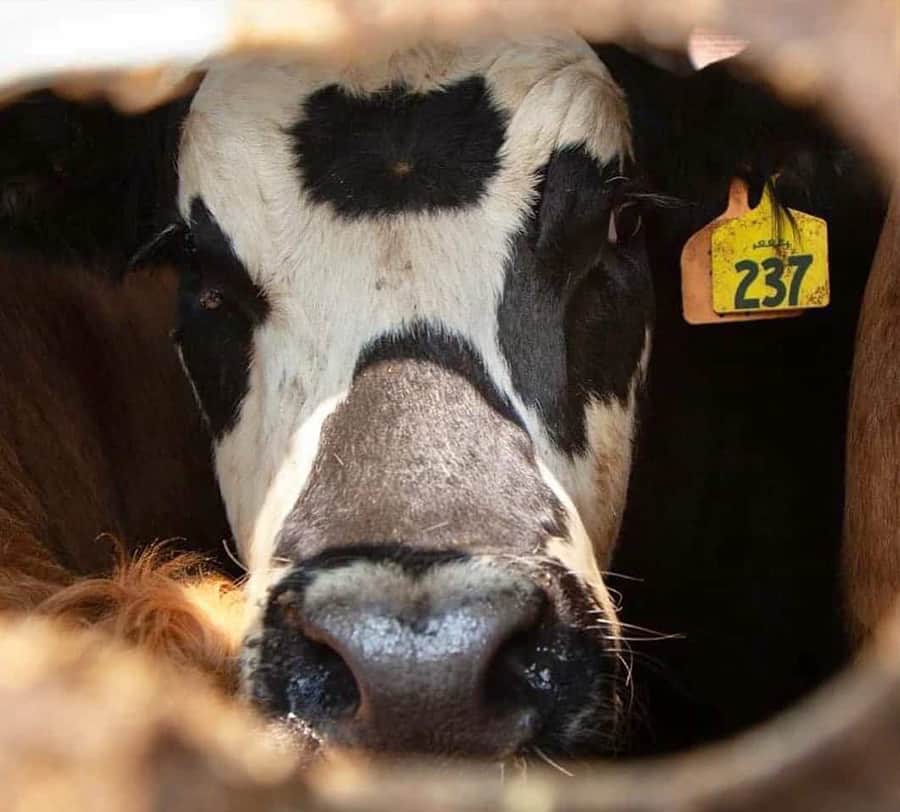
Leather is no friend of the environment, although some leather brands toss around marketing terms like “biodegradable”, “sustainable”, and “eco-friendly”. But if your clothing contains leather from an animal, it is none of these things – these words are greenwashing. The truth is that leather is extremely toxic to our earth and destroys our climate. To turn animal skins into leather, dangerous chemicals are used including formaldehyde, mineral salts, coal-tar derivatives, dyes, oils, and cyanide-based finishes. Strong chemicals like formaldehyde prevent the skins from decaying (they are skins, after all), and are known carcinogens that may cause respiratory problems.
Most leather goes through a process called chrome tanning and chromium is used to make leather durable and resistant to water, but it’s a toxic industrial pollutant classified as a human carcinogen by the National Library of Medicine.
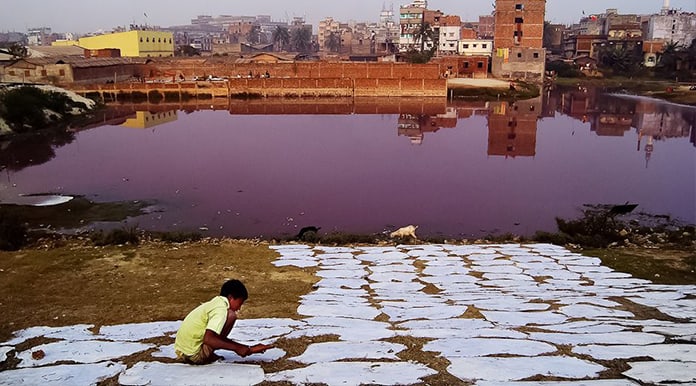
A tannery drying out leather hides next to a body of water that has been heavily polluted by tannery chemicals.
Photo: Daniel Lanteigne under Creative Commons License BY-NC-ND
This hazardous metal can cause cancer and other health issues. Manufacturing leather products with toxic chemicals also affects air quality due to the emission of volatile organic compounds (VOCs) during production. These chemicals evaporate and form pollutants in the air and create environmental issues that can change ecosystem behavior and a loss of biodiversity, in addition to diseases in humans.
Leather Harms Human Health
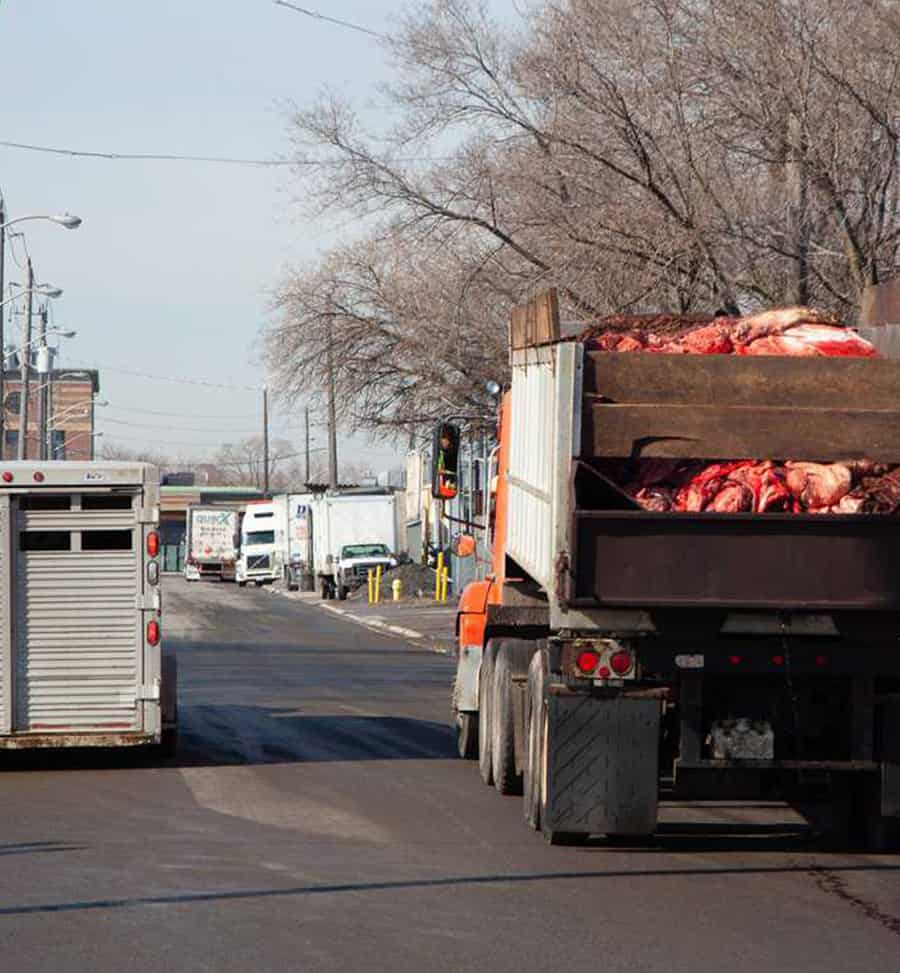
A truck filled with bloody cow skins leaves an Ontario slaughterhouse, passing a trailer filled with live cows on their way in.
Louise Jorgensen / We Animals Media.
Louise Jorgensen, an organizer for Toronto Cow Save and Toronto-based animal rights activist and photojournalist, bears witness to terrified cows heading to slaughter. She has seen cows going into the slaughterhouse alive and their skins being dragged out shortly afterwards.
Jorgensen explains what tannery employees are subjected to.
“The plant is dark, gloomy, and absolutely filthy. The smell of death and the fumes from the toxic chemicals treating the skins is overwhelming, even from outside of the plant. Workers are inhaling these fumes and putting their arms into vats of blood and chemicals.”
Tannery workers’ health is threatened by released toxins and chemical exposure due to high levels of cyanide, arsenic, and lead. Time reports about Bangladesh’s toxic tanneries and the health hazards involved.
“Conditions are nightmarish for the 16,000-plus tannery workers, whose first and secondary exposures to harsh chemicals are said to have reduced life expectancy to less than 50. In the bowels of the M/B Tannery, employees without gloves load chemicals such as chromium and sodium formate into giant churning drums of animal hides. Spillage streaks the factory floor, and many of the workers are mere teenagers.”
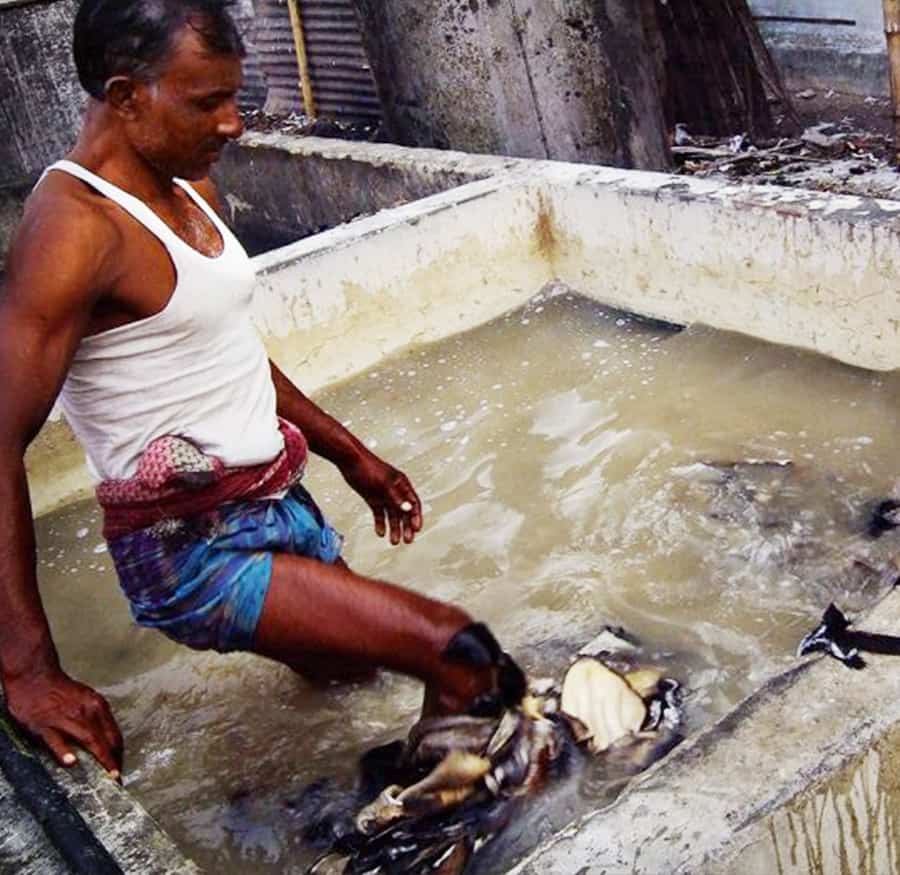
Workers stand knee deep without any protective clothing in tanning water as they transfer rawhides into another tank. Photo: Daniel Lanteigne. Creative Commons BY-NC-ND.
Leather Destroys the Amazon Rainforest
Leather is a coproduct, not a byproduct, of the meat and dairy industries, and cows and other animals on factory farms produce enormous amounts of greenhouse gasses that destroy our planet. These industries are responsible for biodiversity loss, ecosystem degradation, waterway pollution, and the destruction of the Amazon. As outlined in the Safe and Just Report, agriculture ranks among the most significant human activity driving the climate crisis, primarily due to land-clearing, animal farming, and crop production.
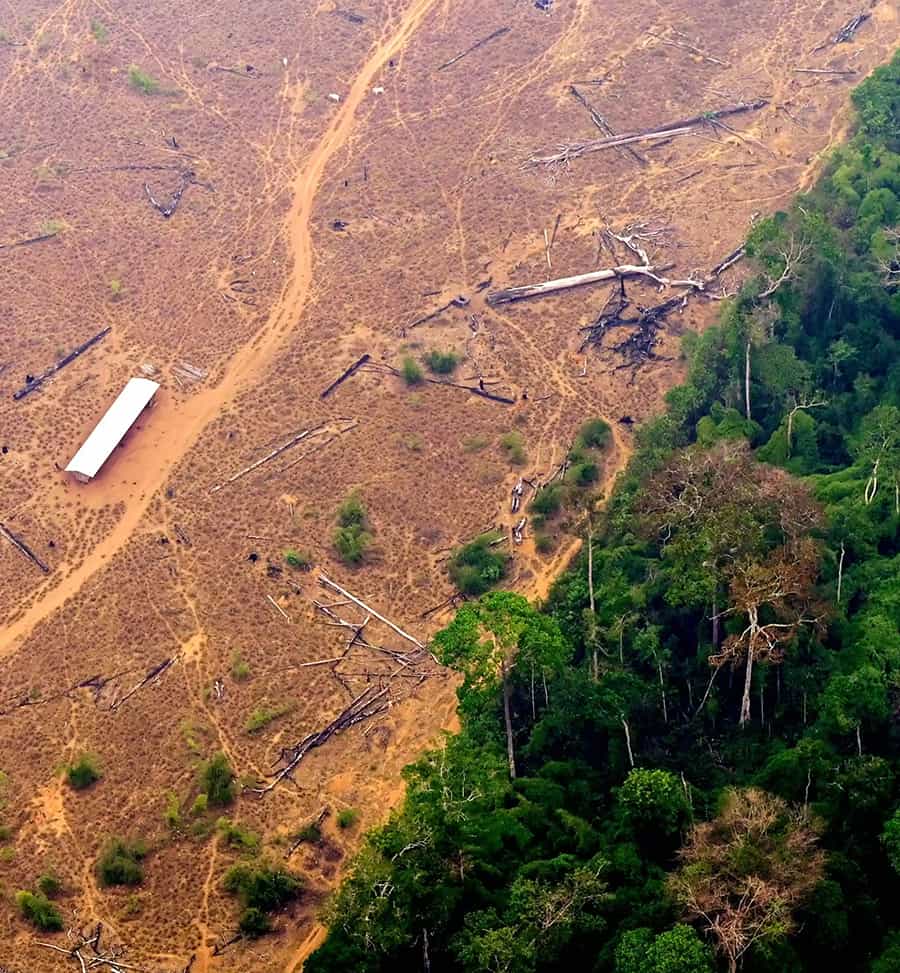
A deforested area of the Amazon rainforest.
Photo: Douglas Magno/AFP/Getty Images
The Amazon Rainforest is the lungs of our planet and a carbon sink, because it absorbs more carbon dioxide than it releases and ejects oxygen. Our planet needs the trees and vegetation of these forests to prevent further global warming and climate change.
Collection Fashion Justice explains that “farming of cattle for beef and leather products is responsible for 80% of the Amazon’s deforestation.”
Stand.earth documents that the leading driver of deforestation in the Amazon Rainforest is the Brazilian cattle industry and the constant demand for meat and leather. They name several clothing brands manufacturing leather products with supply chain links to Brazilian leather exporters including UGG, Adidas, and Coach – all of which are destroying the Amazon to produce leather items.
Leather Causes Environmental Damage
The leather industry requires massive amounts of water, land, animal feed for cows, it consumes fossil fuels, creates environmental pollution and contributes to climate change. Killing animals for their skins and hides directly causes deforestation and lakes and rivers are contaminated from factory farms. Leather, part of the animal agriculture industry, plays a large role in the environmental damage of our planet. In addition to pollution caused by factory farms and slaughterhouses, processing the skins has its own set of extremely negative environmental impacts. Tanning leather generates large amounts of waste and water pollution.

In Hazaribagh (India), the tanneries evacuate 22,000 cubic meters of untreated liquid toxic waste daily. Photo: Daniel Lanteigne. Creative Commons BY-NC-ND.
“Leather has one of the greatest impacts on eutrophication of all materials used for fashion, a serious ecological problem in which runoff waste creates an overgrowth of plant life in water systems, which suffocates animals by depleting oxygen levels in the water and is the leading cause of hypoxic zones, also known as “dead zones.” – PETA
Eco-Friendly Alternatives
The good news is there are so many earth friendly leather alternatives that do not involve killing animals or factory farming. They include cork, cactus leather, pineapple leaf fibers (Pinatex), apple peels, fruit waste, mushroom leather (Mylo), coconut (Malai), and recycled plastic. Compassionate fashion designers like Stella McCartney are using new and innovative materials in their clothing lines. McCartney, an endorser of the Plant Based Treaty, does not use animal materials and encourages other designers to move towards plant-based leather. These alternatives prove it is possible to create fashionable and eco-friendly products that are also cruelty-free.
Vegan leather for the win.

Miriam Porter is an award-winning writer who writes about veganism, social justice issues, and eco-travel. Miriam currently lives in Toronto with her son Noah and many rescued furry friends. She is a passionate animal rights activist and speaks up for those whose voices cannot be heard.
More from the blog
6 More Important Calls To Action From The Safe And Just Report – Part Two
By Miriam Porter
6 Important Calls To Action From The Safe And Just Report – Part One
By Miriam Porter
Grow Your Own Kale And Spinach For Healthy Green Smoothies
By Miriam Porter


